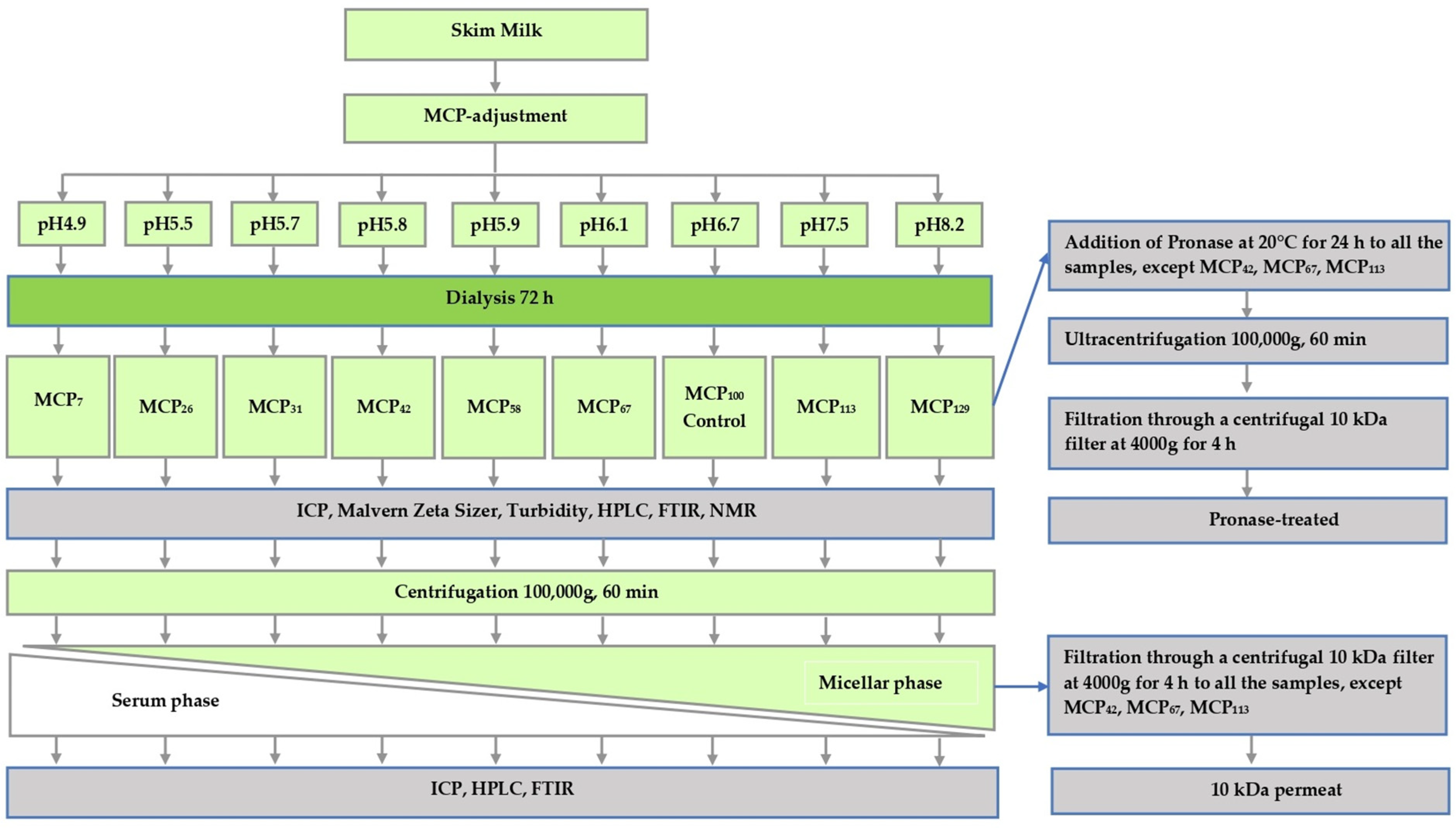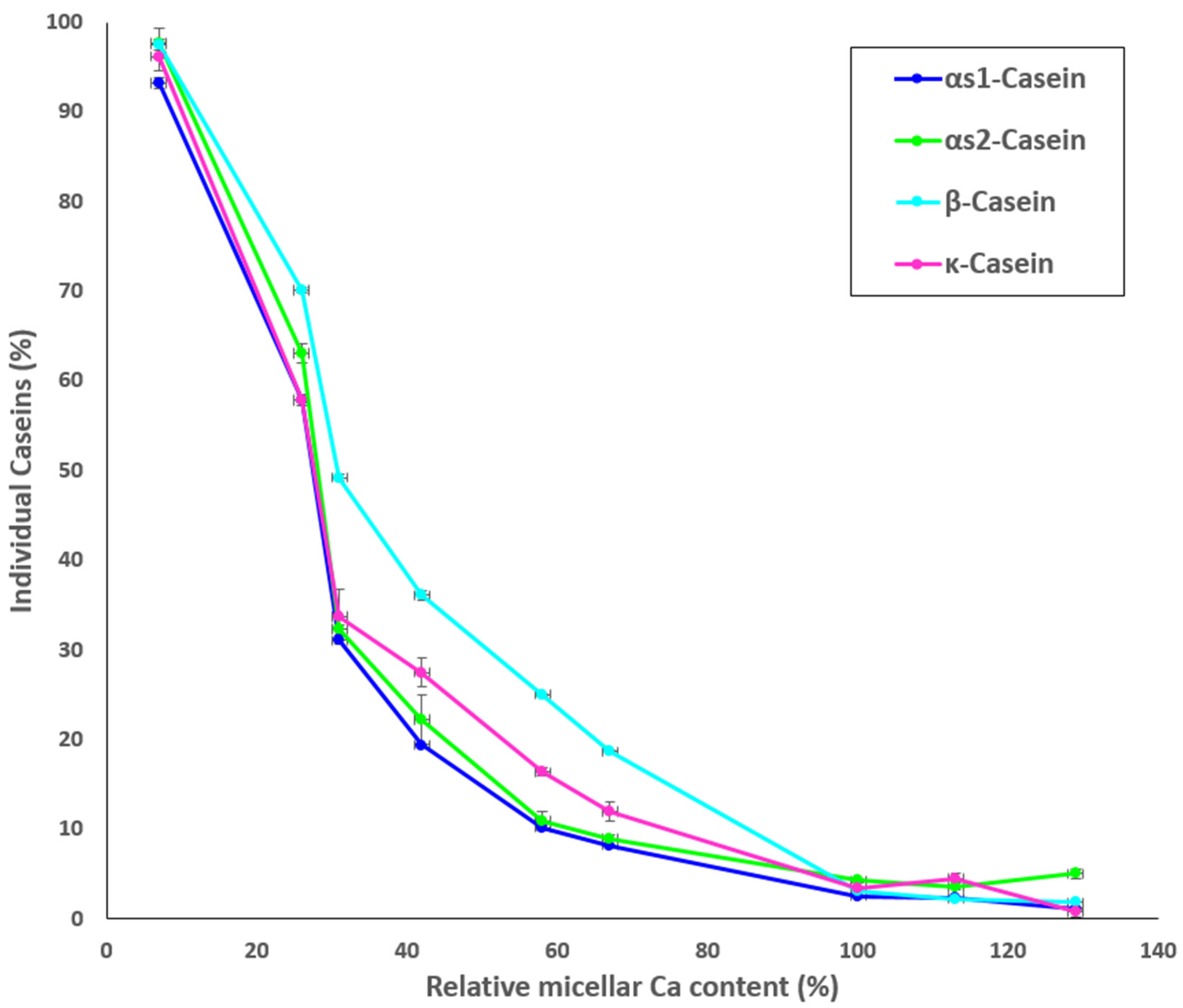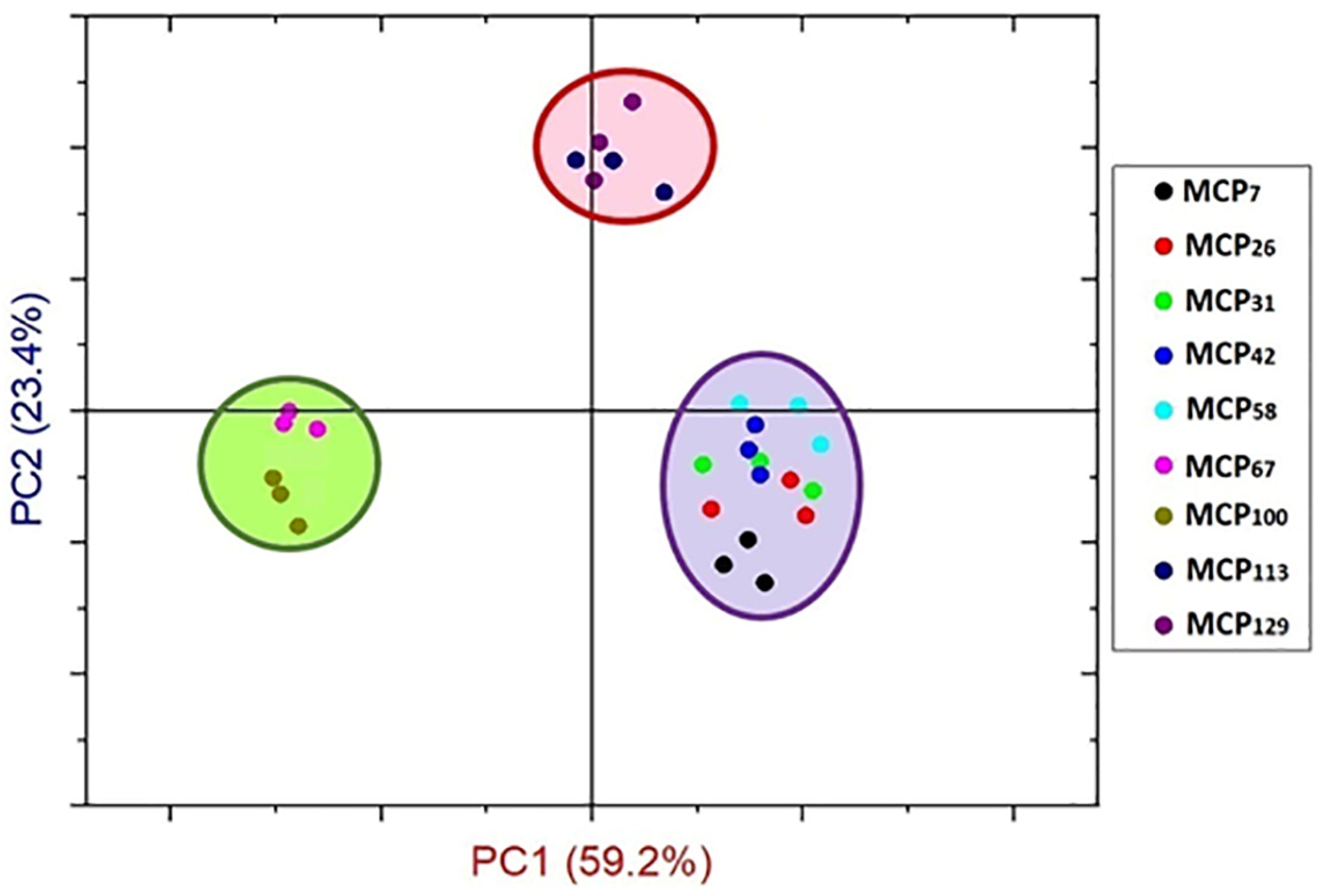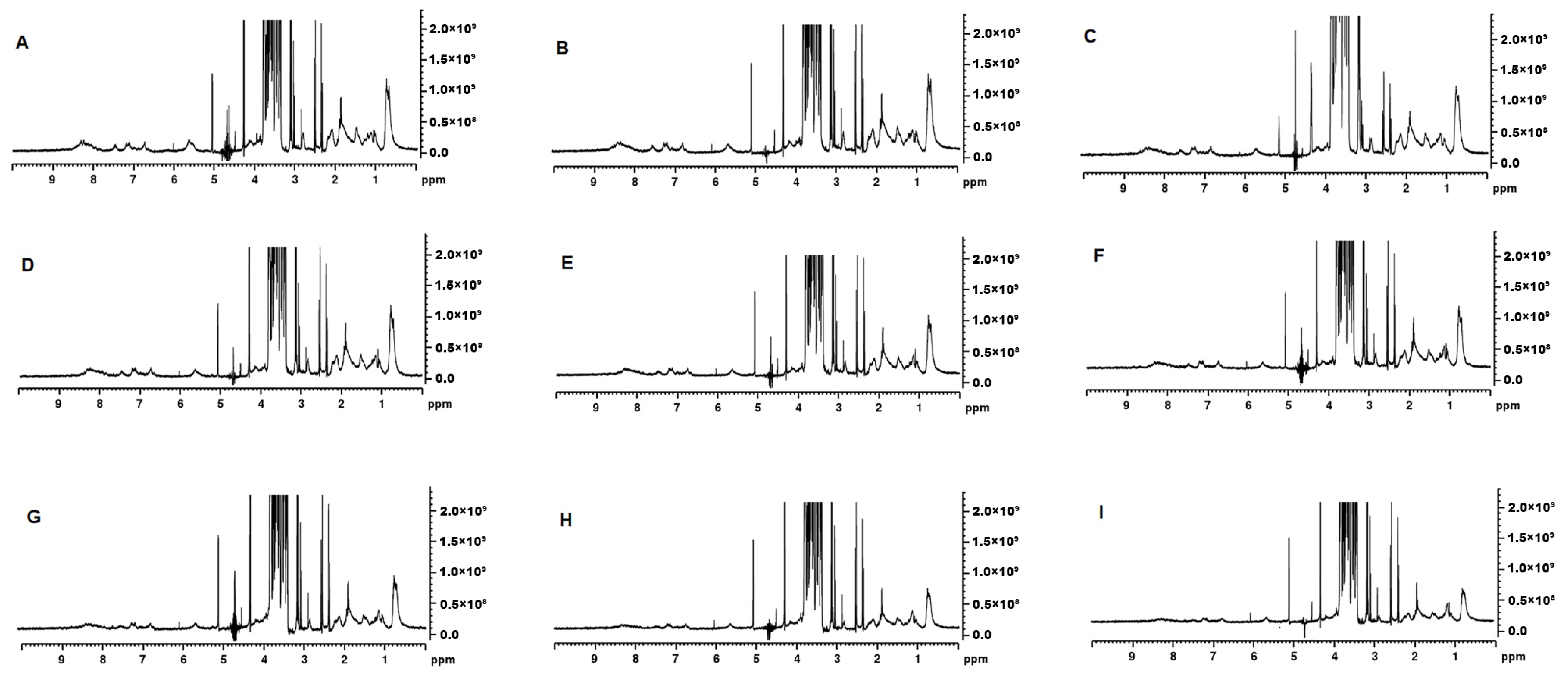Structural Properties of Casein Micelles with Adjusted Micellar Calcium Phosphate Content
Abstract
1. Introduction
2. Materials and Methods
2.1. Materials
2.2. Sample Preparation
2.3. Sample Fractionation
2.4. Sample Analysis
2.4.1. Ca Determination
2.4.2. Particle Size Distribution and Turbidity
2.4.3. High-Performance Liquid Chromatography
2.4.4. Fourier Transform Infrared (FTIR) Spectroscopy
2.4.5. NMR Spectroscopy
2.5. Statistical Analysis
3. Results
3.1. Ca Distribution
3.2. Physicochemical Properties of Skim Milk with the Altered MCP Content
3.3. Distribution of Individual Caseins in the MCP-Adjusted Skim Milk
3.4. Structural Characterisation of MCP Adjusted Skim Milk Samples by FTIR
H and 31P NMR
4. Discussion
4.1. Impact of Micellar Calcium Phosphate Levels on the Casein Micelle Structure
4.2. Micellar Calcium Phosphate Adjustment: Insights from FTIR Analysis
4.3. Micellar Calcium Phosphate Adjustment: Insights from NMR Analysis
5. Conclusions
Supplementary Materials
Author Contributions
Funding
Institutional Review Board Statement
Informed Consent Statement
Data Availability Statement
Conflicts of Interest
References
- Dalgleish, D.G.; Corredig, M. The structure of the casein micelle of milk and its changes during processing. Annu. Rev. Food Sci. Technol. 2012, 3, 449–467. [Google Scholar] [CrossRef] [PubMed]
- Holt, C. Structure and stability of bovine casein micelles. Adv. Protein Chem. 1992, 43, 63–151. [Google Scholar] [CrossRef] [PubMed]
- Gaucheron, F. The minerals of milk. Reprod. Nutr. Dev. 2005, 45, 473–483. [Google Scholar] [CrossRef]
- Schäfer, J.; Mesch, I.; Atamer, Z.; Nöbel, S.; Kohlus, R.; Hinrichs, J. Calcium reduced skim milk retentates obtained by means of microfiltration. J. Food Eng. 2019, 247, 168–177. [Google Scholar] [CrossRef]
- Pyne, G.T.; McGann, T.C.A. The colloidal phosphate of milk: II. Influence of citrate. J. Dairy Res. 1960, 27, 9–17. [Google Scholar] [CrossRef]
- Shalabi, S.I.; Fox, P.F. Influence of pH on the rennet coagulation of milk. J. Dairy Res. 1982, 49, 153–157. [Google Scholar] [CrossRef]
- Anema, S.G. Role of colloidal calcium phosphate in the acid gelation properties of heated skim milk. Food Chem. 2009, 114, 161–167. [Google Scholar] [CrossRef]
- Silva, N.N.; Piot, M.; de Carvalho, A.F.; Violleau, F.; Fameau, A.L.; Gaucheron, F. pH-induced demineralization of casein micelles modifies their physico-chemical and foaming properties. Food Hydrocoll. 2013, 32, 322–330. [Google Scholar] [CrossRef]
- Zhao, Z.; Corredig, M. Serum composition of milk subjected to re-equilibration by dialysis at different temperatures, after pH adjustments. J. Dairy Sci. 2016, 99, 2588–2593. [Google Scholar] [CrossRef]
- Huppertz, T.; Lambers, T.T. Influence of micellar calcium phosphate on in vitro gastric coagulation and digestion of milk proteins in infant formula model systems. Int. Dairy J. 2020, 107, 104717. [Google Scholar] [CrossRef]
- Kommineni, A.; Sunkesula, V.; Marella, C.; Metzger, L.E. Calcium-reduced micellar casein concentrate-physicochemical properties of powders and functional properties of the dispersions. Foods 2022, 11, 1377. [Google Scholar] [CrossRef] [PubMed]
- Fox, P.F.; Hoynes, M.C.T. Heat stability of milk: Influence of colloidal calcium phosphate and β-lactoglobulin. J. Dairy Res. 1975, 42, 427–435. [Google Scholar] [CrossRef]
- Singh, H.; Fox, P.F. Heat stability of milk: Influence of colloidal and soluble salts and protein modification on the pH-dependent dissociation of micellar κ-casein. J. Dairy Res. 1987, 54, 523–534. [Google Scholar] [CrossRef]
- Anema, S.G.; Li, Y. Further studies on the heat-induced, pH-dependent dissociation of casein from the micelles in reconstituted skim milk. LWT-Food Sci. Technol. 2000, 33, 335–343. [Google Scholar] [CrossRef]
- Ahmadi, E.; Vasiljevic, T.; Huppertz, T. Influence of pH on heat-induced changes in skim milk containing various levels of micellar calcium phosphate. Molecules 2023, 28, 6847. [Google Scholar] [CrossRef] [PubMed]
- Jenness, R.; Koops, J. Preparation and properties of a salt solution which simulates milk ultrafiltrate. Neth. Milk Dairy J. 1962, 16, 153–164. [Google Scholar]
- Griffin, M.C.A.; Griffin, W.G. A simple turbidimetric method for the determination of the refractive index of large colloidal particles applied to casein micelles. J. Colloid. Interface Sci. 1985, 104, 409–415. [Google Scholar] [CrossRef]
- Grewal, M.K.; Chandrapala, J.; Donkor, O.; Apostolopoulos, V.; Stojanovska, L.; Vasiljevic, T. Fourier transform infrared spectroscopy analysis of physicochemical changes in UHT milk during accelerated storage. Int. Dairy J. 2017, 66, 99–107. [Google Scholar] [CrossRef]
- Markoska, T.; Daniloski, D.; Vasiljevic, T.; Huppertz, T. Structural changes of β-casein induced by temperature and pH analysed by nuclear magnetic resonance, Fourier-transform infrared spectroscopy, and chemometrics. Molecules 2021, 26, 7650. [Google Scholar] [CrossRef]
- Bijl, E.; Huppertz, T.; Valenberg, H.V.; Holt, C. A quantitative model of the bovine casein micelle: Ion equilibria and calcium phosphate sequestration by individual caseins in bovine milk. Eur. Biophys. J. 2019, 48, 45–59. [Google Scholar] [CrossRef]
- Holt, C.; Davies, D.T.; Law, A.J. Effects of colloidal calcium phosphate content and free calcium ion concentration in the milk serum on the dissociation of bovine casein micelles. J. Dairy Res. 1986, 53, 557–572. [Google Scholar] [CrossRef]
- Ono, T.; Ohotawa, T.; Takagi, Y. Complexes of casein phosphopeptide and calcium phosphate prepared from casein micelles by tryptic digestion. Biosci. Biotechnol. Biochem. 1994, 58, 1376–1380. [Google Scholar] [CrossRef]
- Lyu, P.C.; Sherman, J.C.; Chen, A.; Kallenbach, N.R. Alpha-helix stabilization by natural and unnatural amino acids with alkyl side chains. Proc. Natl. Acad. Sci. USA 1991, 88, 5317–5320. [Google Scholar] [CrossRef]
- Gonzalez-Jordan, A.; Thomar, P.; Nicolai, T.; Dittmer, J. The effect of pH on the structure and phosphate mobility of casein micelles in aqueous solution. Food Hydrocoll. 2015, 51, 88–94. [Google Scholar] [CrossRef]
- Sørensen, H.; Mortensen, K.; Sørland, G.H.; Larsen, F.H.; Paulsson, M.; Ipsen, R. Dynamic ultra-high pressure homogenisation of milk casein concentrates: Influence of casein content. IFSET 2014, 26, 143–152. [Google Scholar] [CrossRef]
- Du, Z.; Xu, N.; Yang, Y.; Li, G.; Tai, Z.; Li, N.; Sun, Y. Study on internal structure of casein micelles in reconstituted skim milk powder. Int. J. Biol. Macromol. 2023, 224, 437–452. [Google Scholar] [CrossRef] [PubMed]
- Rollema, H.S.; Brinkhuis, J.A. A 1H-NMR study of bovine casein micelles; influence of pH, temperature and calcium ions on micellar structure. J. Dairy Res. 1989, 56, 417–425. [Google Scholar] [CrossRef] [PubMed]
- Lemos, A.T.; Goodfellow, B.J.; Delgadillo, I.; Saraiva, J.A. NMR metabolic composition profiling of high pressure pasteurized milk preserved by hyperbaric storage at room temperature. Food Control. 2022, 134, 108660. [Google Scholar] [CrossRef]
- Horne, D.S. Milk Proteins: Casein, Micellar Structure. In Encyclopedia of Dairy Sciences, 2nd ed.; Fuquay, J.W., Ed.; Academic Press: Cambridge, MA, USA; Elsevier: Amsterdam, The Netherlands, 2011; pp. 772–779. [Google Scholar]
- de Kruif, C.G.; Huppertz, T.; Urban, V.S.; Petukhov, A.V. Casein micelles and their internal structure. Adv. Colloid Interface Sci. 2012, 171, 36–52. [Google Scholar] [CrossRef]
- Holt, C. An equilibrium thermodynamic model of the sequestration of calcium phosphate by casein micelles and its application to the calculation of the partition of salts in milk. Eur. Biophys. J. 2004, 33, 421–434. [Google Scholar] [CrossRef]
- Holt, C.; van Kemenade, M.J.; Nelson, L.S.; Sawyer, L.; Harries, J.E.; Bailey, R.T.; Hukins, D.W. Composition and structure of micellar calcium phosphate. J. Dairy Res. 1989, 56, 411–416. [Google Scholar] [CrossRef]
- Thomsen, J.K.; Jakobsen, H.J.; Nielsen, N.C.; Petersen, T.E.; Rasmussen, L.K. Solid-state magic-angle spinning 31P-NMR studies of native casein micelles. Eur. J. Biochem. 1995, 230, 454–459. [Google Scholar] [CrossRef] [PubMed]
- Bak, M.; Rasmussen, L.K.; Petersen, T.E.; Nielsen, N.C. Colloidal calcium phosphates in casein micelles studied by slow-speed-spinning 31P magic angle spinning solid-state nuclear magnetic resonance. J. Dairy Sci. 2001, 84, 1310–1319. [Google Scholar] [CrossRef] [PubMed]
- Hindmarsh, J.P.; Watkinson, P. Experimental evidence for previously unclassified calcium phosphate structures in the casein micelle. J. Dairy Sci. 2017, 100, 6938–6948. [Google Scholar] [CrossRef] [PubMed]
- Munyua, J.K.; Larsson-Raznikiewicz, M. The influence of Ca2+ on the size and light scattering properties of casein micelles 1. Ca2+ removal. Milchwissenschaft 1980, 35, 604–606. [Google Scholar]
- Dalgleish, D.G. Casein micelles as colloids: Surface structures and stabilities. J. Dairy Sci. 1998, 81, 3013–3018. [Google Scholar] [CrossRef]
- Srinivasan, M.; Lucey, J.A. Effects of added plasmin on the formation and rheological properties of rennet-induced skim milk gels. J. Dairy Sci. 2002, 85, 1070–1078. [Google Scholar] [CrossRef]
- Horne, D.S.; Lucey, J.A. Revisiting the temperature dependence of the coagulation of renneted bovine casein micelles. Food Hydrocoll. 2014, 42, 75–80. [Google Scholar] [CrossRef]
- Byler, D.M.; Farrell, J.H.M.; Susi, H. Raman spectroscopic study of casein structure. J. Dairy Sci. 1988, 71, 2622–2629. [Google Scholar] [CrossRef]
- Grewal, M.K.; Vasiljevic, T.; Huppertz, T. Influence of calcium and magnesium on the secondary structure in solutions of individual caseins and binary casein mixtures. Int. Dairy J. 2021, 112, 104879. [Google Scholar] [CrossRef]
- Belton, P.S.; Lyster, R.L.; Richards, C.P. The 31P nuclear magnetic resonance spectrum of cows’ milk. J. Dairy Res. 1985, 52, 47–54. [Google Scholar] [CrossRef]
- Nogueira, M.H.; Ben-Harb, S.; Schmutz, M.; Doumert, B.; Nasser, S.; Derensy, A.; Karoui, R.; Delaplace, G.; Peixoto, P.P.S. Multiscale quantative charazerization of deminieralized casein micelles: How the partial excision of nan-clusters leads to the aggregation during rehydration. Food Hydrocoll. 2020, 105, 105778. [Google Scholar] [CrossRef]
- van Dijk, H.J.M. The properties of casein micelle. 1. The nature of the micellar calcium phosphate. Neth. Milk Dairy J. 1990, 44, 65–81. [Google Scholar]
- Kolar, Z.I.; Verburg, T.G.; van Dijk, H.J. Three kinetically different inorganic phosphate entities in bovine casein micelles revealed by isotopic exchange method and compartmental analysis. J. Inorg. Biochem. 2002, 90, 61–66. [Google Scholar] [CrossRef]
- Lamanna, R.; Braca, A.; Di Paolo, E.; Imparato, G. Identification of milk mixtures by 1H NMR profiling. Magn. Reson. Chem. 2011, 49, S22–S26. [Google Scholar] [CrossRef] [PubMed]






| Sample Code 1 | pH of Milk Prior to Dialysis | Total Ca (mmol L−1) | Supernatant Ca (mmol L−1) | 10 kDa Permeable Ca (mmol L−1) | 10 kDa-Permeable Ca of Pronase-Treated Milk (mmol L−1) | Nanocluster-Associated Ca (mmol L−1) |
|---|---|---|---|---|---|---|
| MCP7 | 4.9 | 14.74 ± 1.01 E | 13.24 ± 0.50 A | 12.49 ± 0.26 A | 12.65± 1.56 | 2.09 ± 0.06 F |
| MCP26 | 5.5 | 18.24 ± 3.19 DE | 12.53 ± 2.19 AB | 11.48 ± 0.94 AB | 13.54 ± 1.38 | 4.70 ± 0.20 E |
| MCP31 | 5.7 | 19.23 ± 5.06 DE | 12.51 ± 2.30 AB | 11.64± 0.53 AB | 12.84 ± 1.33 | 6.39 ± 0.09 D |
| MCP42 | 5.8 | 21.38 ± 3.42 CD | 12.32 ± 2.07 AB | N/A | N/A | N/A |
| MCP58 | 5.9 | 23.68 ± 3.38 CD | 11.08 ± 0.72 AB | 11.49 ± 2.38 AB | 13.21± 1.14 | 10.47 ± 0.06 C |
| MCP67 | 6.1 | 25.42 ± 1.55 C | 10.92 ± 0.87 AB | N/A | N/A | N/A |
| MCP100 | 6.7 | 32.23 ± 1.79 B | 10.72 ± 0.67 AB | 9.78 ± 0.09 B | 11.72± 2.33 | 20.51 ± 0.02 B |
| MCP113 | 7.5 | 35.43 ± 2.83 AB | 11.04 ± 0.48 AB | N/A | N/A | N/A |
| MCP129 | 8.2 | 38.17 ± 3.19 A | 10.47 ± 0.28 B | 11.63 ± 1.58 AB | 13.92± 1.57 | 24.25 ± 0.10 A |
| Sample | Particle Diameter (nm) | Turbidity (cm−1) |
|---|---|---|
| MCP7 | 83 ± 8 D | 0.08 ± 0.01 I |
| MCP26 | 115 ± 7 C | 0.14 ± 0.01 H |
| MCP31 | 140 ± 17 B | 0.23 ± 0.00 G |
| MCP42 | 158 ± 14 A | 0.26 ± 0.00 F |
| MCP58 | 163 ± 8 A | 0.29 ± 0.00 E |
| MCP67 | 162 ± 5 A | 0.32 ± 0.00 D |
| MCP100 (control) | 163 ± 4 A | 0.41 ± 0.00 A |
| MCP113 | 169 ± 11 A | 0.40 ± 0.00 B |
| MCP129 | 165 ± 5 A | 0.39 ± 0.00 C |
| Band Assessment | Side Chain | β-Sheet | Random Coil | α-Helix | β-Turn | Aggregated β-Sheet |
|---|---|---|---|---|---|---|
| Band Frequency (cm−1) | 1608–1611 | 1620–1631 | 1640–1649 | 1658–1666 | 1668–1681 | 1689–1694 |
| MCP7 | 1.1 ± 0.02 g | 11.8 ± 0.20 ab | 16.9 ± 1.34 a | 24.2 ± 1.88 abc | 44.8 ± 0.98 ab | 1.2 ± 0.21 ef |
| MCP26 | 1.9 ± 0.23 fg | 6.6 ± 0.35 d | 15.0 ± 2.28 ab | 21.6 ± 0.49 bc | 52.3 ± 2.20 a | 2.4 ± 0.13 def |
| MCP31 | 3.8 ± 0.11 e | 6.7 ± 0.03 d | 11.4 ± 0.59 ab | 22.5 ± 0.03 bc | 52.0 ± 0.02 a | 3.5 ± 0.43 de |
| MCP42 | 2.3 ± 0.09 f | 1.9 ± 0.33 e | 13.9 ± 1.27 ab | 33.3 ± 1.72 a | 48.4 ± 2.76 ab | 0.1 ± 0.02 f |
| MCP58 | 9.5 ± 0.45 d | 3.2 ± 0.33 e | 9.9 ± 0.42 b | 23.5 ± 1.81 bc | 50.6 ± 2.75 a | 2.9 ± 0.42 de |
| MCP67 | 10.3 ± 0.03 d | 9.8 ± 0.67 bc | 11.9 ± 3.61 ab | 30.5 ± 1.09 ab | 34.0 ± 5.57 cd | 4.8 ± 0.03 d |
| MCP100 | 15.2 ± 0.28 c | 6.9 ± 2.09 cd | 11.1 ± 1.57 ab | 15.1 ± 6.27 c | 40.8 ± 0.54 bc | 10.8 ± 1.80 c |
| MCP113 | 32.6 ± 0.18 a | 13.2 ± 0.18 a | 10.1 ± 0.22 b | 2.6 ± 0.10 d | 21.9 ± 0.05 e | 19.5 ± 0.37 b |
| MCP129 | 24.1 ± 0.42 b | 6.5 ± 0.02 d | 17.2 ± 0.13 a | 2.8 ± 0.00 d | 26.7 ± 0.25 de | 22.7 ± 0.29 a |
Disclaimer/Publisher’s Note: The statements, opinions and data contained in all publications are solely those of the individual author(s) and contributor(s) and not of MDPI and/or the editor(s). MDPI and/or the editor(s) disclaim responsibility for any injury to people or property resulting from any ideas, methods, instructions or products referred to in the content. |
© 2024 by the authors. Licensee MDPI, Basel, Switzerland. This article is an open access article distributed under the terms and conditions of the Creative Commons Attribution (CC BY) license (https://creativecommons.org/licenses/by/4.0/).
Share and Cite
Ahmadi, E.; Markoska, T.; Huppertz, T.; Vasiljevic, T. Structural Properties of Casein Micelles with Adjusted Micellar Calcium Phosphate Content. Foods 2024, 13, 322. https://doi.org/10.3390/foods13020322
Ahmadi E, Markoska T, Huppertz T, Vasiljevic T. Structural Properties of Casein Micelles with Adjusted Micellar Calcium Phosphate Content. Foods. 2024; 13(2):322. https://doi.org/10.3390/foods13020322
Chicago/Turabian StyleAhmadi, Elaheh, Tatijana Markoska, Thom Huppertz, and Todor Vasiljevic. 2024. "Structural Properties of Casein Micelles with Adjusted Micellar Calcium Phosphate Content" Foods 13, no. 2: 322. https://doi.org/10.3390/foods13020322
APA StyleAhmadi, E., Markoska, T., Huppertz, T., & Vasiljevic, T. (2024). Structural Properties of Casein Micelles with Adjusted Micellar Calcium Phosphate Content. Foods, 13(2), 322. https://doi.org/10.3390/foods13020322






